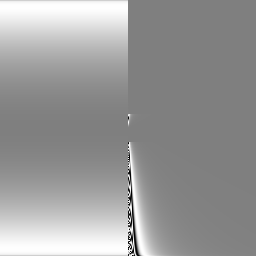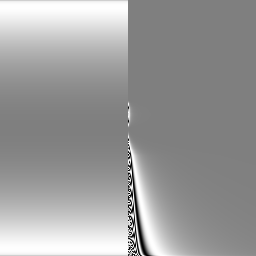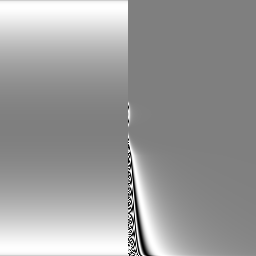Evolutionary Procedural Modeling
with
Symbolic Expressions
a summary by Markus Altmann
Procedural modeling techniques allow the creation of highly complex
structures, textures and animations at a low cost [SIMS]. This is
performed with a set of parameters - relatively simple input
information - and a procedure using these parameters to generate the
complexity. A good example for this is a highly detailed mountain
terrain generated by fractal subdivision [WATT].
However, these techniques are inevitably specific in their application
[WATT]. In addition, the user has to conceive, understand and design
the details of the procedure. Another drawback to consider is the difficulty
of maintaining sufficient control over the results. This loss of control
increases as more options are added to the procedure, to get more
variations of the results[SIMS].
With an evolutionary approach, the user still does not have complete control
over the detail of the results. However, this approach allows the
creation of a large variety of complex entities, resulting from a
minimum of user directed input [SIMS]. Moreover, the user himself is
not required to understand the creation processes involved and his
role is to select the resulting structures to direct the evolution
process.
Definitions
Evolution simulated by a computer involves the same basic
concepts as in biology. The genotype is the genetic
information (here, a set of procedural parameters, or
symbolic expressions), for creating an individual, the
phenotype. The process for generating the phenotype from the
genotype and the developmental rules (here, procedures), is called
expression.
A further process is selection, which determines the fitness
of phenotypes, the ability to survive and reproduce. Fitness
in simulated evolution can be determined by evaluation of a defined
fitness function or, here, by the aesthetic whim of the user
[WATT][SIMS].
For evolution to progress, a reproduction of an existing
genotype or genotypes should occur, to generate new
genotypes. Therefore, there must be variation or
mutation in new genotypes with some frequency and then
perform the selection on the resulting phenotypes and to get a higher
level of fitness [SIMS]. Another way to obtain new genotypes is
sexual combination of genetic material from more than one
genotype (parents), allowing independently evolved features to be
combined into a single individual (child).
Simulated Evolution within Parameter Space
Here, the genotype is represented by a set of N input parameters
(parameter vector [WATT]). Each parameter has an effect in the the
expression procedure(s), assembling the phenotype (structure). The
possible values of each parameter build up an N-dimensional space,
covering the corresponding set of possible structures.
There are two methods for creating structures. One method is the
modification of the parameter values by hand for adjusting the
structure result. However, predicting the effect of modifications of
parameters and combinations of them becomes increasingly difficult as
more options are supported by the expression procedure, i.e. as more
parameters have to be specified.
The second method allows the selection of a pleasing sample or samples.
The samples are generated randomly in the neighborhood of an existing
parameter set by random alteration of one or several parameters. This
method doesn't require the knowledge of specific effects of each
parameter and the parameter space can be explored in incremental
arbitrary directions.
Mutation of Parameter sets
For evolution, the parameter set has to be mutated with some
probability during the reproduction. In [SIMS] the parameters of the
parent genotype are normalized [0.0, 1.0] and copied to the new child
genotype with a certain probability of mutation m (cond.:
rand(0.0, 1.0) >= m). In case of mutation (rand(0.0, 1.0) <
m), the parameter of the parent is modified by adding a
random mutation distance +/-d. Since parameter values are
normalized, the mutation distance is proportional to the scale of the
value range of the parameter. After mutation, the normalized values
are scaled, offset and optionally squared to the appropriate parameter
values.
Mating of Parameter Sets
Mating of two parameter sets, representing different structures with
desirable features, enables the combination of these features into a
single structure. This reproduction with sexual combination can be
accomplished with one of four methods in [SIMS]:
- Copying gene sequences while switching between parents with some
frequency, so adjacent genes are more likely to stick together.
- Independent copying of each gene from one of the parents with equal
probability.
- Child receives random p% of one parent's genes and (100-p)% from
the other. This results into a linear interpolation between parent
genotypes for p = 50.
- Each child gene gets a random value between values of corresponding
parent genes (genes independently interpolated).
Evolution with Symbolic Expressions
Genotypes with fixed parameter sets and fixed expression rules put
solid boundaries on the set of possible phenotypes. Using symbolic expressions
as genotypes, surpasses these boundaries. Genotypes of symbolic
expressions also include procedural information beside the data and
are not restricted to a certain structure or size. Therefore, mutation
can not only adjust existing expression parts, but also create larger
expressions with new parameters.
An expression is generated from random selections in a set of functions,
which could be standard mathematical functions/operations, Boolean &
image processing operations etc. The necessary function arguments are
also randomly chosen and could be scalar, vectors, variables (X, Y
pixel coord.) or even another expression, resulting in - desirable -
nested expressions. The created expression can then be evaluated by
varying the values of the expression variables, corresponding to pixel
coordinates (Fig. 1).

Fig. 1: Result of the expression:
( -( ( *( ( abs( ( +( X ( ^( 0.000
rand() )) )) )) ( -( ( log( ( abs( ( atan( X )) )) )) ( ^( Y X )) ))
)) T )),
X and Y are changed form -1 to 1, T = 1.0
Mutating symbolic Expressions
The mutation should only slightly modify the expression, because large
changes in a genotype usually cause a very different phenotype. Such a
phenotype need not to be an improvement, but this is important to extend
the expression for more complex structures.
[SIMS] uses a recursive scheme, traversing an expression as a tree
structure, for the actual mutation. Each node of the tree can be
mutated (see following list), while the frequency of the mutation type
depends on the node type: ('->' denotes mutation / becomes)
- any node -> new random expression, which allows large
changes/alternations of genotype/phenotype
- scalar/vector node -> scalar/vector components, adjusted by
addition of random amount
- function node -> different function (adjustment of arguments
necessary)
- expression -> argument of new random function (necessary arguments
generated at random)
- argument of function -> new node value (inverse of 4.)
- node -> copy of another node from parent expression
in the expression (duplication of sub-expression)
The mutation frequencies are scaled inversely proportional to the length
of the parent expression and should be adjusted, so that a lower
complexity is slightly more probable than higher one.
Mating Symbolic Expressions
Here, sub-expressions from different genotypes are mixed into a single
individual, and [SIMS] describes two methods to do so:
- The two parents should be of equal (tree) structure for simultaneous
traversal. The similar nodes are copied to the new
expression (child), and on differences, one node from the parents is
copied with equal probability. The offspring usually will not vary
greatly form the parents, and if the parents have different root nodes,
no new combination will result.
- A crossing over technique is used, by replacing a random chosen
node of one parent with a random one from the other, allowing even
dissimilar expressions to be combined.
Evolving Volume Texture & Animations
For these purposes additional variables are added to the possible
arguments to choose from. The evolution of volume textures involves a
Z variable and an adjustment of the function set (e.g. 3D solid noise
generation) to evaluate expressions in 3D space.
Evolution of animations can also be done by including a Time
variable into the expression, so images are produced for smooth
changes of Time (Fig 2).




Fig 2: Lifting the curtain of complexity (just a bit - left to
right/top to bottom). Expression used:
( sin( ( sqr( ( *( ( asin( ( atan( ( tan( Y
)) )) )) ( /( ( &( T Y )) X )) )) )) ))
X & Y like in Fig. 1, T = 0.01 to 0.31 in steps of 0.1
There are four more methods for animation in [SIMS]:
- Genetic cross dissolve between two expressions of similar
structure, which is performed by interpolating the results where
the expressions differ. These results are first calculated &
dissolved, and then used by the remaining expression parts to generate
a smooth transition between the two expressions.
- Instead of a Time argument, an Image argument can be
integrated into an expression. This allows complex manipulations of
images, whose values are used by the expression evaluation. The values
of Image correspond to frames of an existing animation.
- When using pixel coordinates (X, Y) to determine the pixel color,
altering the mapping of X & Y, e.g. via zooming, 3D perspective
transformation, etc., before expression evaluation, animates an
image.
- Smooth interpolation of parameters in expression to new values.
Finally, all above mentioned methods for animation can be combined.
Conclusion
Artificial evolution is a powerful tool for the procedural generation of
structures, texture & motion. When using genotypes with symbolic
expressions, there are no limits in complexity and no understanding is
required for creating & exploring the complexity. The interactive work
of user & computer can produce results, neither could do alone. In
order to allow interactive work, fast generation of samples to choose
from is necessary. Finally, all the results can be saved in a concise
form by the genotype itself, i.e. the formulation of the symbolic
expression.
References
- [SIMS]
- Karl Sims,
"Artificial Evolution for Computer Graphics",
July 1991, Computer Graphics, Vol. 25, No. 4, pp. 319 - 328
- [WATT]
- Alan Watt, Mark Watt,
"Advanced Animation and Rendering Techniques",
1992, AMC press, New York, Addision-Wesley
![[Return to CS563 '95 talks list]](/images/back.gif)
Markus Altmann /
madwpi@cs.wpi.edu





